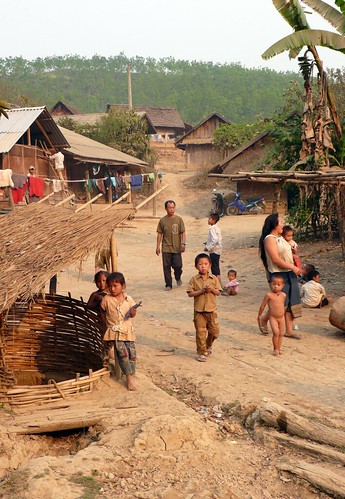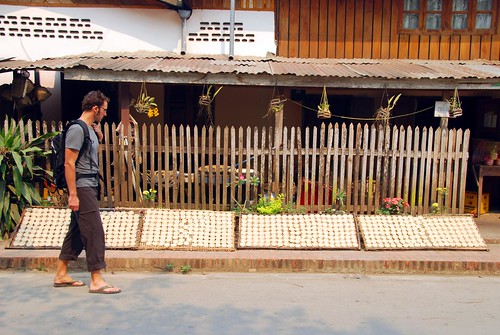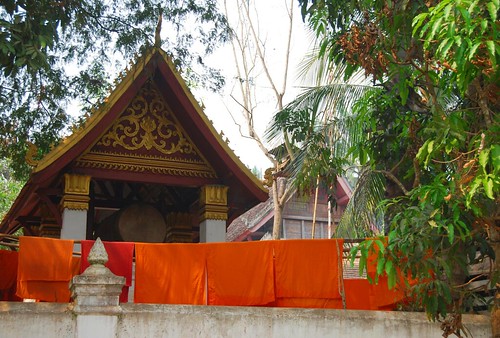If there is one thing you won’t want to do in Laos, it’s rush. We really didn’t get to spend enough time here or see that much of the country, but we were in Laos long enough to get the flavor of the place. And what exactly does Laos taste like? Dust. Sticky rice. Tranquility. Shyness. Noodle soup. Divinity. Poverty. Beerlao. Golden sunsets. And, if it is possible to taste such a thing, the flavor of time standing still.
Day spent here: 7
Places we visited: Luang Prabang, Luang Nam Tha
Places we would like to visit next time: Southern Laos, especially Champasak and Si Phan Don
Prices: We found the prices in Luang Prabang to be quite high. It is possible to find cheap accommodation and food, but it’s no fun eating at the market every night. Every so often, you want to eat in a restaurant, and in LP, that can set you back about US$5-10 per person. On the other hand, Luang Nam Tha was quite cheap…we paid 60,000 kip (approx. US$7) for our room, and dinners at the local restaurant were only about US$3-5 each (even cheaper for a bowl of noodles at the LNT night market).
Similar to Vietnam, prices in Laos are often quoted in US dollars, though you can pay with dollars, kip, or even Thai baht. The exchange rate was US$1 = 8,500 kip.
Weather: While we were in Laos (early March), it was nothing but HOT. There was not a whisper of wind to speak of, and combined with the smoke in the air, it made the heat very oppressive.
Transit: We traveled only by public bus in Laos…there were no other options to the areas we were headed (Luang Prabang to Luang Nam Tha, and Luang Nam Tha to the border town of Huay Xai).

Village kids running to gawk at us on the public bus. Somwhere between Luang Nam Tha and Huay Xai.
Laotian public buses are old are they are notorious for breaking down, though luckily, this never happened to us. The roads are not exactly in the best condition, so bus rides are typically very long and bumpy. Also, Laotian public buses do not have air conditioning, so the windows are left open, leaving you and your lungs covered in layers of Laotian dust.
Internet: Our free Internet spree ended once we boarded the plane in Hanoi. Wireless internet was available in Luang Prabang, usually for about 10,000 kip per hour. Connection speeds were quite slow, however. There was no wireless in Luang Nam Tha.
Food and drink: You have not had Laotian food until you have had sticky rice. It is served in a woven bamboo basket and eaten with the hands (you pull out a chunk, and pinch your meat/vegetables between the sticky rice).

Jeremy walking by some sticky rice cakes drying in the sun, Luang Prabang.
Otherwise, Laotian food is very similar to Thai food. Their rice noodle soups are tasty! Also, the bread in Laos is incredible. Vietnamese French bread is very airy, but Laotian bread is dense, more similar to the bread in France. For lack of a better way of describing it, the bread in Laos seemed more “gourmet.” In Luang Prabang, we found these Laotian sandwiches at the market that were stuffed with grilled chicken, tofu, lettuce, cucumber, and then drizzled with sweet chili sauce. At 10,000 kip (approx. US$1.20) per sandwich, these sandwiches were our tasty, cheap, and filling lunch treats on many LP days.
Similarly, you cannot leave Laos without drinking Beerlao. That’s not a command, it’s an actuality…I am not sure if you an even get any other beers in small Laotian towns! It’s cheap, too…about 12,000 kip for a big bottle which you can split amongst two (or not, depending on how much you drink). ![]()
Culture: Laotians are a very shy and reserved (but sweet) people. Coming from Vietnam, it can be both a positive and negative culture shock; positive because everyone pretty much leaves you alone (which is nice after being constantly harassed to spend your money on this or that in Vietnam), but negative because it is harder to get to know the people here. I think that’s why it’s a good idea to linger a while in Laos, it seems like the kind of place that grows on you (and vice versa). Unfortunately, we just didn’t have enough time to spend here.
That reserved nature carries itself into the culture in other interesting ways…for instance, all around town (in both LP and LNT), there are signs posted in English explaining how Westerners should behave in Laos (i.e., don’t point the bottom of your feet at Buddhas, public displays of affection are frowned upon, women should not touch monks, etc.). Laotians (or at least the government) seem very interested in preserving Laotian culture (though we’ve heard rumblings that this could be due to paranoia rather than any lofty cultural goals—apparently the government is ever-wary of the US invading its social, cultural, and governmental structures, even though most Americans would most likely not be able to point Laos out on a map).
In other ways, though, we found Laos to be quite progressive. Certainly the artisan culture is very alive here and we were pleasantly surprised by the quality and variety of souvenirs and trinkets aimed at the tourist market. Whereas in other SE Asian countries the offerings were limited to cheap plastic sunglasses and logo t-shirts, in Luang Prabang, we saw beautiful embroidered quilts, woven tapestries, and handmade books.

Textile weaver in Ban Phanom village outside of Luang Prabang.
In short: Most travelers probably love Laos because, unlike other SE Asian countries, the people will just leave you be and let you enjoy the country without their intervention. I will admit that Laos’ peaceful nature is really seductive, but on the other hand, chance encounters with locals is what makes a place really special (for me anyway)—I treasure the opportunity to learn about their world through their eyes. Since Laotians are naturally more reserved, it can take a while to figure out how to get them to open up to you. I wish we had more time to spend in this lovely country, a week was not enough time to lure Laos out of its shell.
